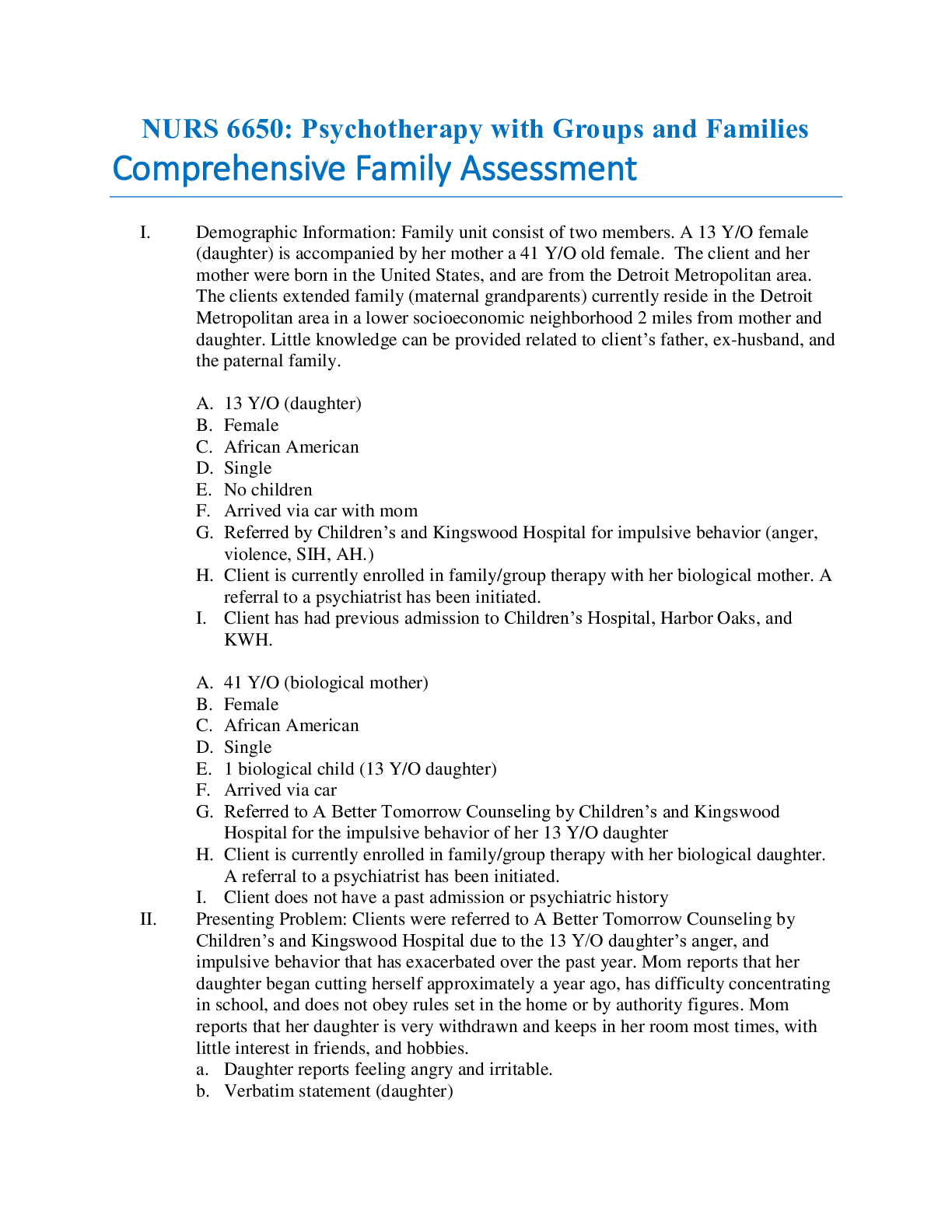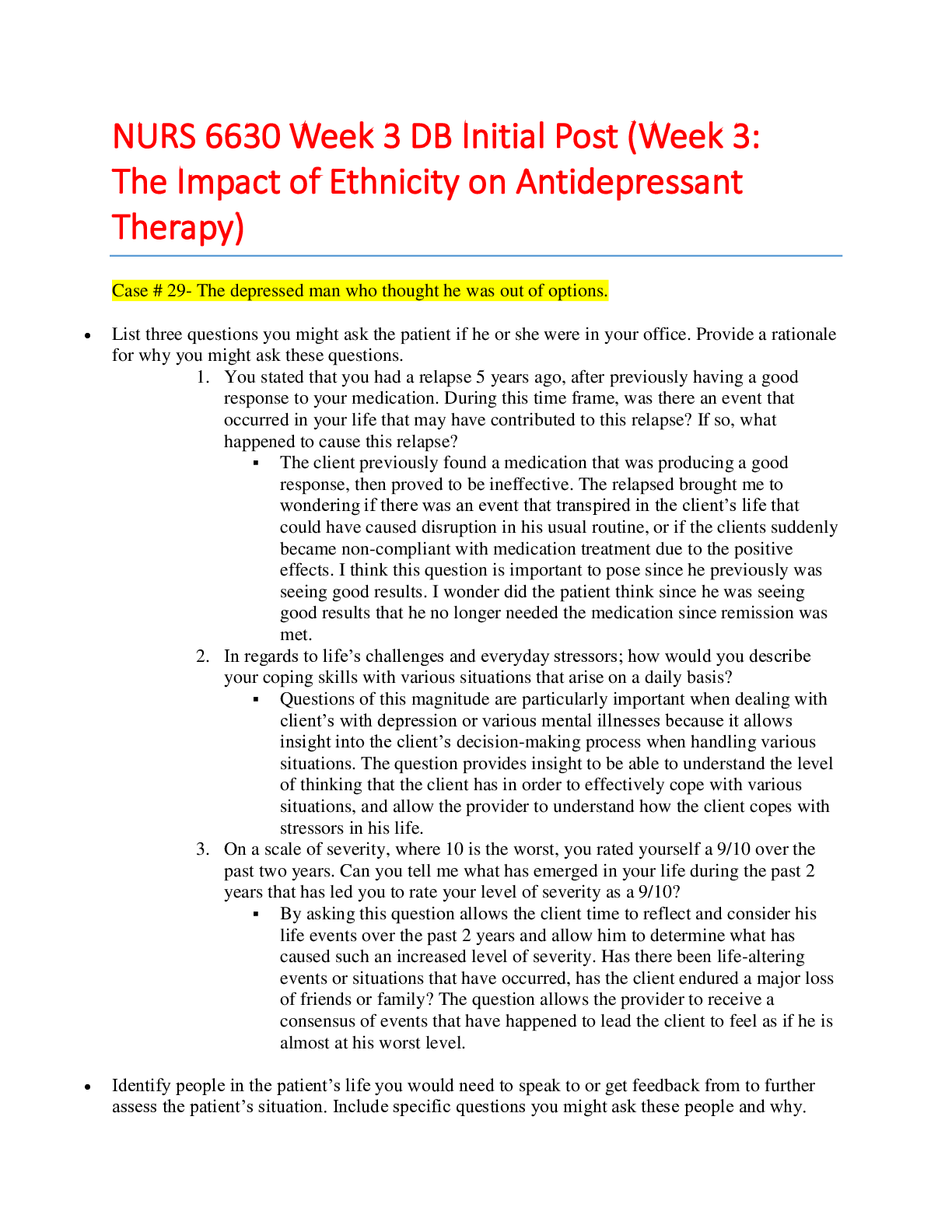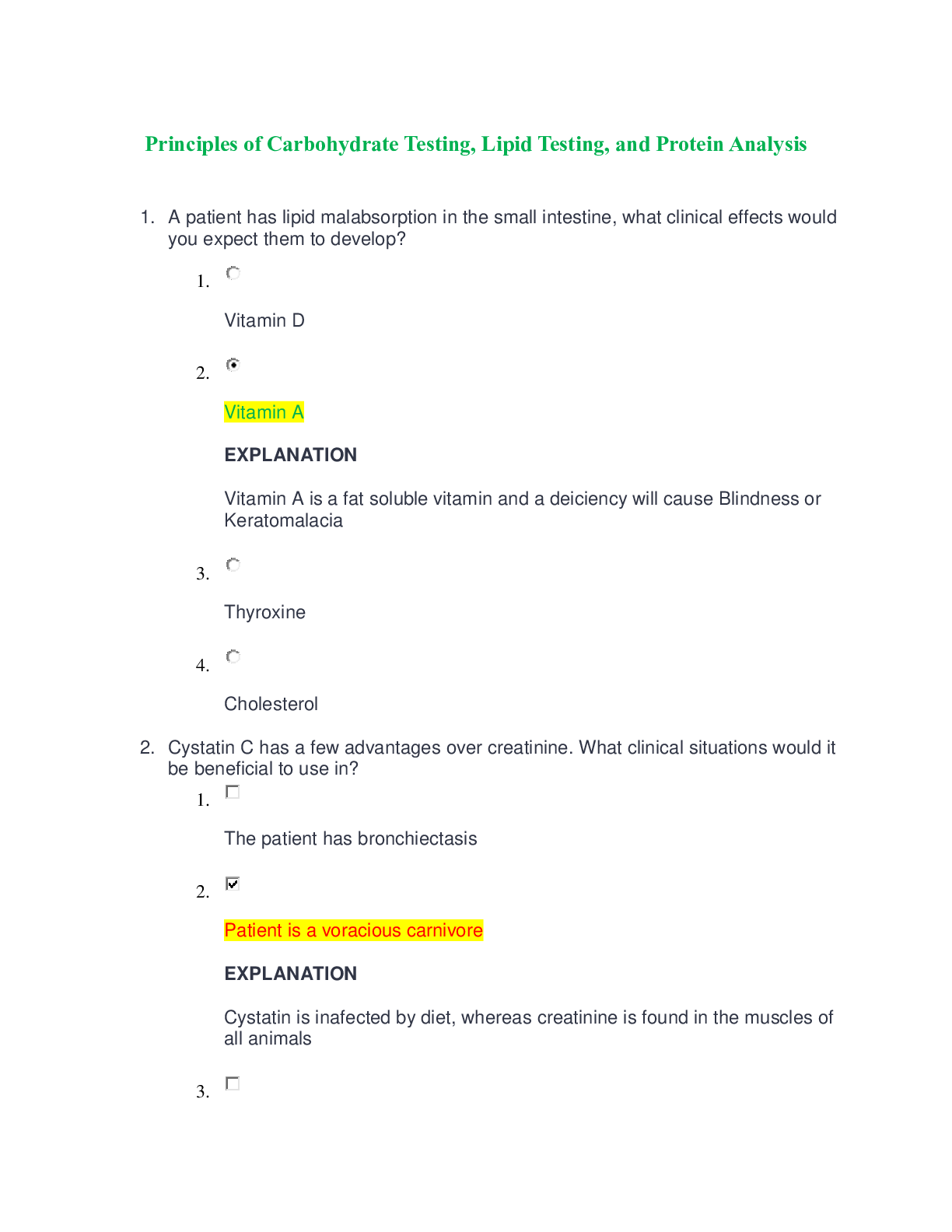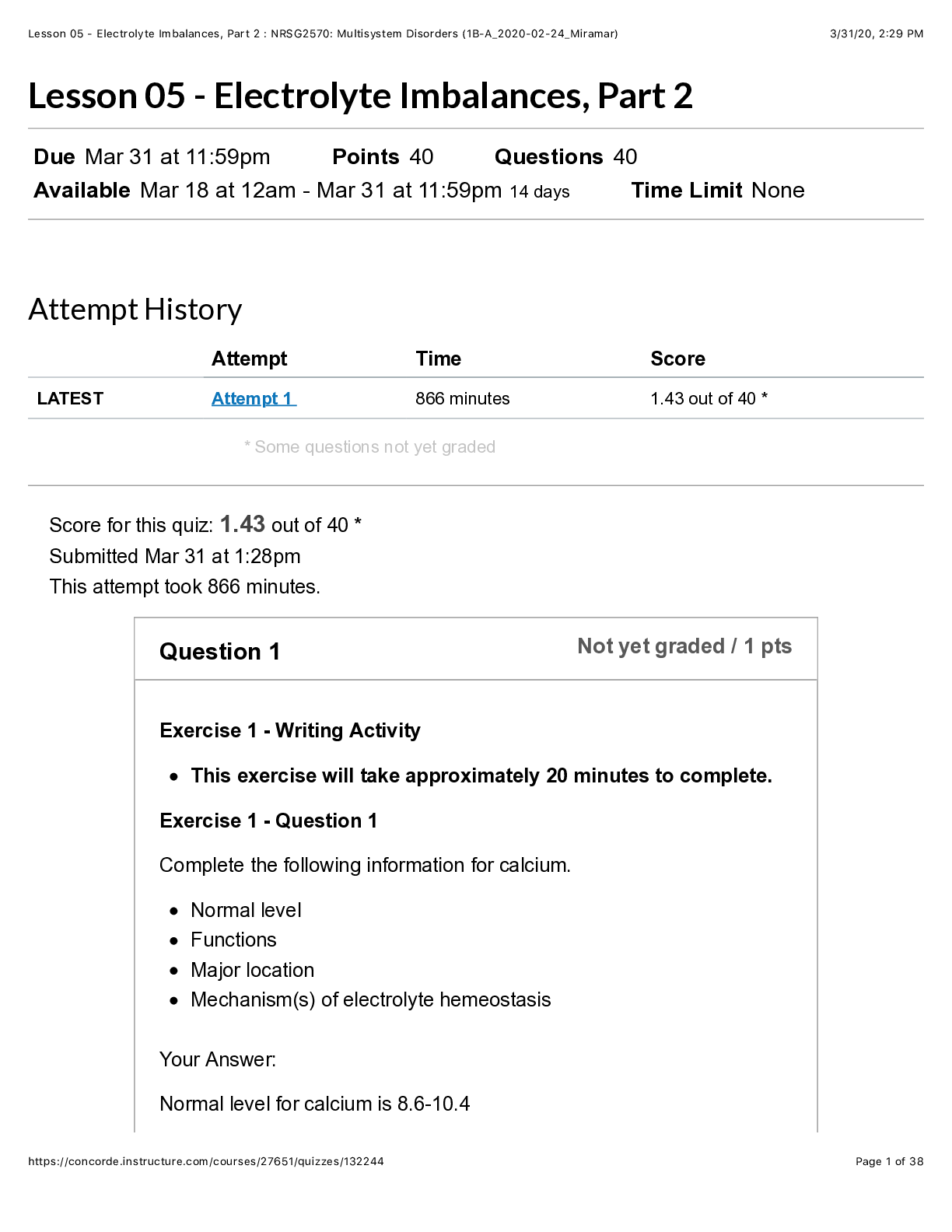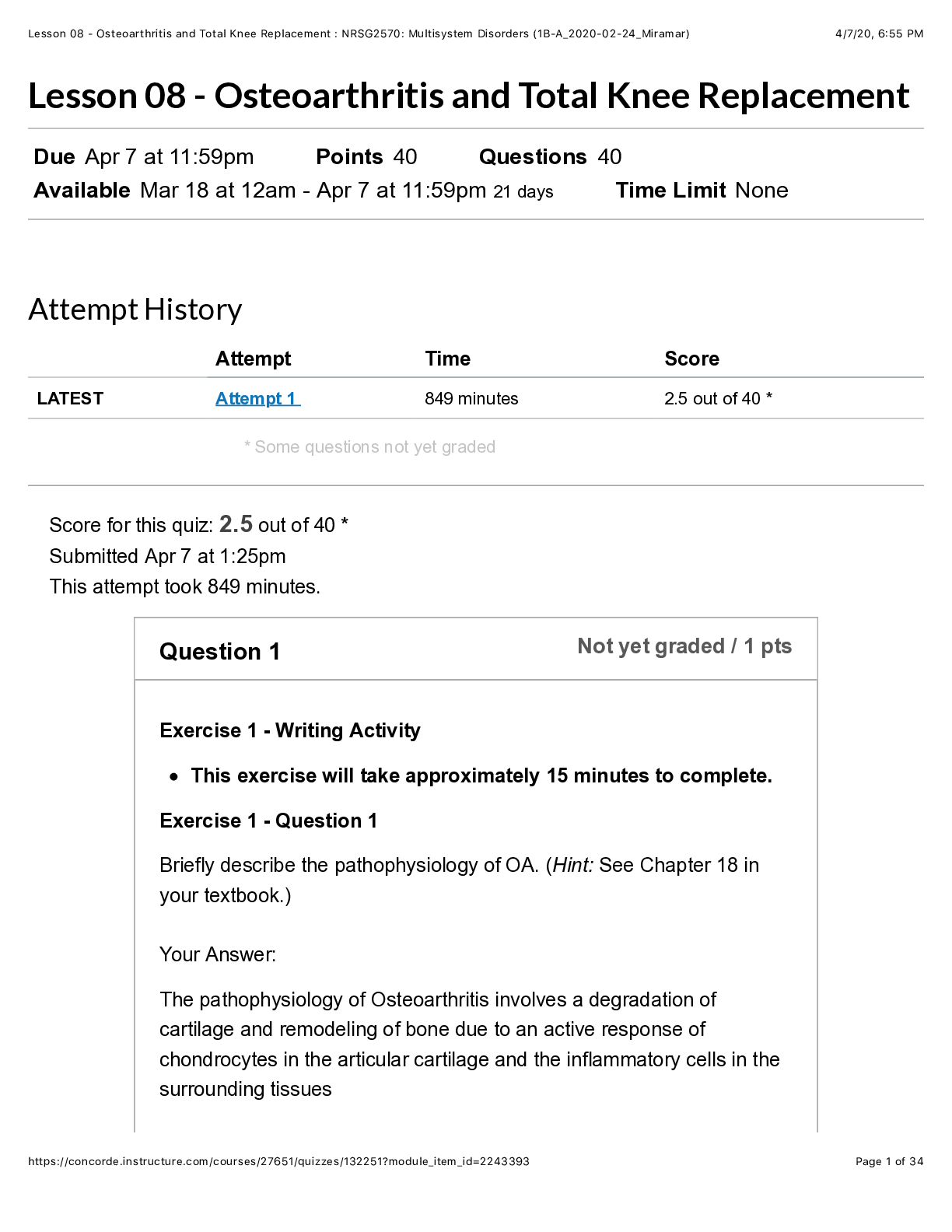*NURSING > QUESTIONS & ANSWERS > NUR 1234 Lesson 04 Electrolyte Imbalances, Part 1_ NRSG2570_ Multisystem Disorders | Miami Dade Coll (All)
NUR 1234 Lesson 04 Electrolyte Imbalances, Part 1_ NRSG2570_ Multisystem Disorders | Miami Dade College, Miami
Document Content and Description Below
Lesson 04 - Electrolyte Imbalances, Part 1 Due Mar 31 at 11:59pm Points 31 Questions 31 Available Mar 18 at 12am - Mar 31 at 11:59pm 14 days Time Limit None Attempt History Attempt Time Score ... Question 1 Not yet graded / 1 pts Your Answer: Exercise 1 - Writing Activity This exercise will take approximately 10 minutes to complete. Exercise 1 - Question 1 Describe the general function of electrolytes. Electrolytes, or ions, are substances dissolved in body fluid that carry electrical charge. Electrolytes are minerals that carry an electric charge when they are dissolved in a liquid such as blood. The blood electrolytes—sodium, potassium, chloride, and bicarbonate—help regulate nerve and muscle function and maintain acid-base balance and water balance. Question 2 1 / 1 pts Exercise 1 - Question 2 Match each term with its corresponding definition. (A) A negatively charged ion (B) A substance in body fluids that carries an electrical charge; an electrolyte (C) A positively charged ion Anion A Cation C Ion B Correct! Correct! Correct! Correct! Correct! Correct! Question 3 1 / 1 pts Exercise 1 - Question 3 Question 4 Not yet graded / 1 pts Your Answer: Exercise 1 - Question 4 Identify the specific functions of potassium within the body. (Hint: See Chapter 11 in your textbook.) Potassium is one of the most important minerals in the body. It helps regulate fluid balance, muscle contractions and nerve signals. It is the major cation of the intercellular fluid (ICF). Question 5 Not yet graded / 1 pts Your Answer: Exercise 1 - Question 5 Describe the physiologic influences on potassium balance. Some of the physiologic influences on the potassium balance is: Polarization and repolarization of nerve and muscle fibers. Transmission and conduction of nerve and muscle impulses Cellular growth Maintiance of cardiac rhythms Acid-bace balance Potassium is the major cation of the intracellular fluid (ICF). The normal serum potassium level ranges from 3.5 to 5.0 mEq/L or mmol/L. The normal ICF potassium level is about 140 mEq/L (mmol/L). The main controller of the ECF potassium is the sodium potassium pump within the membranes of all body cells. This pump moves extra sodium ions from the ICF and moves extra potassium ions from the ECF back into the cell. In this way, the serum potassium level remains low and the cellular potassium remains high. Question 6 Not yet graded / 1 pts Your Answer: Exercise 2 - Virtual Hospital Activity This exercise will take approximately 45 minutes to complete. Sign in to work at Pacific View Regional Hospital for Period of Care 1. (Note: If you are already in the virtual hospital from a previous exercise, click on Leave the Floor and then on Restart the Program to get to the sign-in window.) From the Patient List, select Piya Jordan (Room 403). Click on Go to Nurses’ Station. Click on Chart and then on 403. Click on Laboratory Reports. Exercise 2 - Question 1 What was Piya Jordan’s initial potassium level on Monday at 2200? Potassium 3.3 3.3 mEq/L Question 7 1 / 1 pts Exercise 2 - Question 2 When considering Piya Jordan's age, which is a therapeutic serum potassium level? 3.5 to 5.0 mEq/L Question 8 Not yet graded / 1 pts Your Answer: Click on Emergency Department and review this record. Exercise 2 - Question 3 What would be the most likely cause for hypokalemia in this patient? (Hint: See Table 11-7 in your textbook.) Pts symptoms: Vomiting, weakness, inappropriate or excessive use of drugs. Causes for hypokalemia is: diuretics, digitalis-like drugs, corticosteroids, increased secretion of aldosterone, cushing's syndrome, diarrhea, wound drainage, prolonged nasogastric suction, heat-induced excessive diaphoresis, kidney disease impairing reabsorption of potassium, NP status. Prolonged nausea and vomiting Your Answer: Click on Physician's Orders. Scroll down and review the orders for Monday at 2200. Exercise 2 - Question 4 What did the physician order to treat this electrolyte imbalance? Is this appropriate? Is the dilution and rate safe to administer? (Hint: See Chapter 11 in your textbook.) The Physician ordered: Question 10 Not yet graded / 1 pts Question 11 Not yet graded / 1 pts Your Answer: Exercise 2 - Question 6 When administering potassium chloride intravenously, what guidelines for the rate of administration should be observed? A dilution no greater than 1 mEq (mmol/L) of potassium to 10 ml of solution is recommended for IV administration. The maximum recommended infusion rate is 5-10 mEq/hr (mmol/hr); this rate is never to exceed 20 mEq/hr (mmol/hr) under any circumstances. In accordance Question 12 Not yet graded / 1 pts Your Answer: Click on Return to Nurses' Station. Click on 403 at the bottom of your screen. Click on Patient Care and then on Physical Assessment. Complete physical assessment of Piya Jordan by clicking on the body categories (yellow buttons) and body subcategories (green buttons). Click on Take Vital Signs. Exercise 2 - Question 7 Specifically looking for clinical manifestations of hypokalemia, document your findings, focusing on the assessment areas listed below. Place an asterisk by any findings that correlate with hypokalemia. (Hint: Refer to Chapter 11 in your textbook.) Respiratory Musculoskeletal Cardiovascular Neurologic Intestinal Respiratory: Nothing correlates with hypokelmia Musculoskeletal: Upper extremities *Mild weakness in strength. Lower extremities *Mild weakness in strength, unsteady gait. Cardiovascular: *Apical rhythm irregular Neurologic: *Mildly confused, restless, and agitated. Respiratory: Musculoskeletal: Cardiovascular: Neurologic: Intestinal: Question 13 Not yet graded / 1 pts Your Answer: Click on Chart and then on 403. Then click on Laboratory Reports. Exercise 2 - Question 8 What was the potassium level that was drawn on Wednesday at 0630? Piya's potassium level that was drawn on Wed at 0630 was 3.4 3.4 Question 14 Not yet graded / 1 pts Your Answer: Exercise 2 - Question 9 Explain the etiology for this recurrence of hypokalemia. There are a number of factors that could be causing the recurrence of hypokelemia: NG tube that is on low continuous suction. Diet: NPO Continuous NG tube suctioning Question 15 Not yet graded / 1 pts Your Answer: Click on Physician’s Orders. Exercise 2 - Question 10 What did the physician order in response to today’s potassium level? The physician ordered: 20 mEq Potassium Chloride in 250 mL NS IV infuse over two hours once, now Potassium chloride 20 mEq IV in 250 mL NS to infuse over 2 hours Question 16 Not yet graded / 1 pts Your Answer: Prepare to administer this ordered dose of potassium chloride to Piya Jordan by completing the following steps: Click on Return to Room 403. Click Medication Room on the bottom of your screen. Click on IV Storage near the top of your screen. Click on the bin labeled Small Volume and review the list of available medications. (Note: You may click on Review MAR at any time to verify correct medication order. Remember to click on the correct tab and to look at the patient name on the MAR to make sure you have the correct patient's record. Click on Return to Medication Room after reviewing the correct MAR.) From the list of medications in the bin, select potassium chloride. Click Put Medication on Tray and then on Close Bin. Click View Medication Room. Click on Preparation. Select the correct medication to administer; then click Prepare. Wait for instructions or questions from the Preparation Wizard. Then click on Next. Choose the correct patient to administer this medication to. Click on Finish. You can click Review Your Medications and then on Return to Medication Room when ready. From the Medication Room, go directly to Piya Jordan’s room by clicking on 403 at the bottom of your screen. Before you administer IV medications, the patient’s IV site must be assessed. Click on Patient Care and then on Physical Assessment. Click on Upper Extremities. Click on Integumentary from the system subcategories. Exercise 2 - Question 11 Document the IV site assessment findings below. Is it appropriate to administer the IV potassium at this time? Question 17 Not yet graded / 1 pts Your Answer: After you have collected the appropriate assessment data and are ready for administration, click on Medication Administration. (Note: If you are not still in the Patient Care screen, you will need to first click on Patient Care and then on Medication Administration.) On the left side of the window that appears, select the correct patient name and room number. If you prepared the patient's medication properly, the name of the medication will appear in the middle window. Complete the Administration Wizard and click Administer to Patient when done. Check Yes when asked whether this drug administration should be documented on the MAR and then click on Finish. Now click on MAR at the top of your screen. Exercise 2 - Question 12 What are Piya Jordan’s scheduled morning medications? What medication would you question giving her, and for what reason? (Hint: See Chapter 11 in your textbook.) Piya's scheduled morning meds are: every 4 hours PRN nausea *20 mEq Potassium Chloride in 250 mL NS IV infuse over 2 hours once I might be confused but I would question, the potassium chloride, to be infused over 2 hours, because a dilution no greater than 1 mEq (mmol/L) of potassium to 10 ml of solution is recommended for IV administration. The maximum recommended infusion rate is 5-10 mEq/hr (mmol/hr); this Question 18 Not yet graded / 1 pts Exercise 2 - Question 13 Question 19 0.25 / 1 pts Exercise 2 - Question 14 When considering pain at the site of the IV infusion, which manifestations are consistent with extravasation? Select all that apply. Pain Warmth Cool skin at site Absence of blood return Swelling Question 20 Not yet graded / 1 pts Click on Leave the Floor at the bottom of your screen. From the Floor Menu, select Look at You Preceptor's Evaluation. Then click on Medication Scorecard. Exercise 2 - Question 15 Disregard the report for the routine scheduled medications, and instead note below whether or not you correctly administered the potassium chloride. If not, why do you think you were incorrect in administering this drug? According to Table C in this scorecard, what are the appropriate resources that should be used and important assessments that should be completed before administering this medication? Did you utilize and perform them correctly? Table C: Resources used for Piya Jordan. Medical Records How often did you access the patient's medical records? CHART 0 MAR 1 EPR 0 KARDEX 0 Patient Information: When did you check your patient? Arm Band 0732 Allergy 0732 Clinical Alerts Vital Signs 0732 Question 21 Not yet graded / 1 pts Your Answer: Exercise 3 - Virtual Hospital Activity This exercise will take approximately 30 minutes to complete. Sign in to work at Pacific View Regional Hospital for Period of Care 1. (Note: If you are already in the virtual hospital from a previous exercise, click on Leave the Floor and then on Restart the Program to get to the sign-in window.) From the Patient List, select Patricia Newman (Room 406). Click on Go to Nurses’ Station. Click on Chart and then on 406. Click on Laboratory Reports. Exercise 3 - Question 1 What was Patricia Newman’s initial potassium level this morning? Patricia's potassium level for this morning is 3.2 3.2 mEq/L Question 22 Not yet graded / 1 pts Your Answer: Click on History and Physical. Exercise 3 - Question 2 What would be the most likely cause for hypokalemia in this patient? I would say that it is inappropriate or excessive use of drugs: Chlorothiazide Chlorothiazide 500 mg daily; diuretic therapy with insufficient increase in potassium intake Question 23 Not yet graded / 1 pts Your Answer: Click on Physician's Orders. Exercise 3 - Question 3 What did the physician order on Wednesday at 0730 to treat this electrolyte imbalance? The physician ordered: Increase Potassium chloride to 40 mEq/liter in IV fluid. Increase potassium chloride to 40 mEq per liter Question 24 Not yet graded / 1 pts Your Answer: Exercise 3 - Question 4 What is missing from this order? The infusion instructions is missing from this order. The rate of the IV infusion Question 25 Not yet graded / 1 pts Your Answer: Exercise 3 - Question 5 Where could you verify this missing information? I could verify it in the MAR Look at the physician’s initial and most recent IV rate orders. You can also call the physician if you cannot find the data for this specific order. Question 26 Not yet graded / 1 pts Exercise 3 - Question 6 Question 27 Not yet graded / 1 pts Your Answer: Exercise 3 - Question 7 Look again at the physician’s orders. Is there an order for any follow-up lab work? What is the nurse’s responsibility in regard to follow-up lab work, and how would you handle this situation? There isn't an order for follow up lab work. The nurse should ask the doctor whether or not he wants to check her potassium level after administration of the medication, in order to asses whether the patient is still hypokalemic. Question 28 0 / 1 pts Exercise 3 - Question 8 When planning Patricia Newman's dietary intake, which selection is considered the best source of potassium? Salmon Bread Question 29 Not yet graded / 1 pts Click on Return to Nurses’ Station. Click on 406 at the bottom of the screen. Click on Patient Care and then on Nurse-Client Interactions. Select and view the video titled 0740: Evaluation—Response to Care. (Note: Check the virtual clock to see whether enough time has elapsed. You can use the fast-forward feature to advance the time by 2-minute intervals if the video is not yet available. Then click again on Patient Care and then on Nurse-Client Interactions to refresh the screen.) Question 30 Not yet graded / 1 pts Your Answer: Exercise 3 - Question 10 How does the nurse respond to this expressed concern? Is it an adequate response? She responds by saying that Patricias potassium was low. Hypokalemia can cause shallow respirations, because of muscle weakness. The nurse really does not respond to the patient’s concern regarding worsening lung disease. Instead, the nurse tells the patient that potassium was ordered and will be added to her IV while it is running. Although the patient does need teaching regarding her potassium, the nurse’s response did not use therapeutic communication techniques and the patient's needs were not met. [Show More]
Last updated: 11 months ago
Preview 4 out of 23 pages

Loading document previews ...
Buy this document to get the full access instantly
Instant Download Access after purchase
Buy NowInstant download
We Accept:

Reviews( 0 )
$8.00
Can't find what you want? Try our AI powered Search
Document information
Connected school, study & course
About the document
Uploaded On
May 14, 2021
Number of pages
23
Written in
Additional information
This document has been written for:
Uploaded
May 14, 2021
Downloads
0
Views
92



